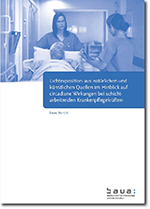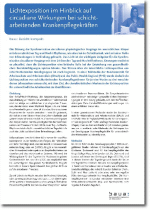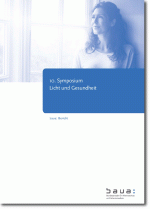- Project number: F 2355
- Institution: Federal Institute for Occupational Safety and Health (BAuA)
- Status: Completed Project
Description:
Shift work, which is associated with a disturbance in the synchronization of circadian physiological processes in the human body with natural 24-hour day-night rhythm, is associated with a number of diseases. Since the identification of a new non-visual photoreceptive mechanism that is active in regulating physiological processes, the influence of light on the circadian rhythms has been investigated under laboratory conditions. To support better understanding of a possible connection between shift work and health risks, studies of personal light exposures in field studies are of great importance.
A total of 85 nurses from the Klinikum Dortmund and the King’s College Hospital in London took part in the joint study by the Federal Institute for Occupational Safety and Health (BAuA) and the Public Health England (PHE). The nurses in Dortmund (42) were either shift workers who worked in three 8-hour shifts (early, late and nightshift) or 8-hour day working nurses. The nurses in London (43) did either a 12-hour shift (day and nightshift) or an 8-hour day shift. They recorded light exposure both during and outside working hours for a week and in three seasons (winter, spring and summer) using a detector attached to the chest.
The goal was to identify the characteristic features of the light exposure of this profession. To estimate the light exposure effective for the non-visual system, the light exposure in the blue spectral range was considered. In addition, the illuminance is also recorded, relating to the influence of light on the visual system. The following applies to the two light exposures:
- Working time-related and seasonal differences in light exposure are clearly recognizable in both Dortmund and London, despite large intra- and inter-individual differences.
- The light exposure on working days is basically determined by the working time and reaches its maximum values during the journey to and from the workplace.
- The light exposure from artificial lighting sources indoors at work and at home is much lower than the relatively short-term exposure to natural daylight outdoors.
- While the 8-hour working days in Dortmund and London enabled higher light exposures at least on the way to work or home, the average light exposure on 12-hour working days in London is for all seasons low due to the full-time stay of nurses at work.
- While seasonal differences in light exposure between winter and summer are clearly recognizable, differences between spring and summer strongly depended on the respective weather conditions.



